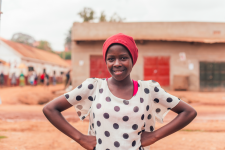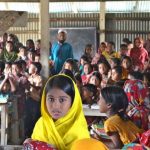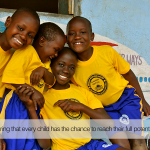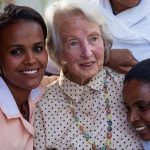Empowering Adolescent Girls: An Interview With Plan Australia’s Holly Crocket

Kampala is ranked amongst the fastest growing cities in Africa, and reported crime is on the rise Cases of robbery, rape and harassment are common. This has led to a situation where 80 percent of the adolescent girls living in the capital of Uganda don’t feel safe in public.
So, three young women – Zaharah (pictured), Jackline and Sharon – have decided to take matters into their own hands and are calling on the Kampala Capital City Authority to step up its efforts to address threats to girls’ safety throughout the city.
Currently, some streets around Kampala are signposted, but most aren’t. This makes it difficult for police to respond to any incidents. And this issue, coupled with a lack of street lighting and a lot of unfinished buildings leaves girls walking the streets vulnerable to violence, especially at night.
So far, the trio’s campaign has been a success. They’ve lined up a meeting with the Kampala Capital City Authority later this month. And right now, they’re gathering signatures on an online petition, which they’ll be presenting to those in charge of the city’s operations.
These three young women are all part of Plan International Australia’s Safer Cities for Girls program, which is a project that’s providing adolescent girls with the skills and resources they need in order to successfully advocate for the changes that will make their cities safer and more inclusive.
The barriers they face
There are half a billion adolescent girls in the developing world. And according to Plan Australia, these 10 to 19-year-old girls hold the key to lifting their families out of poverty and transforming the economies in their countries.
However, these girls can face multiple barriers within their communities due to a lack of equality. And this discrimination based on gender begins at an early age. It means that boys are afforded greater resources and freedoms than girls are. And this inequality can ultimately lead to gender-based violence.
The disparity between the genders becomes particularly pronounced in times of crisis. During responses to humanitarian emergencies the needs of adolescent girls are often overlooked, and there’s a lack of understanding as to how their societal roles can affect their access to resources.
The United Nations Population Fund has recognised 10-year-old girls as the key demographic for achieving sustainable development in their communities. However, without empowering their rights and safeguarding their health this cannot be achieved.
The rights of girls
Plan Australia released its Half a Billion Girls report in March. It outlines that Australia’s current aid and development agenda neglects the needs of teenage girls. And it makes the case that investment in adolescent girls is the best strategy to break intergenerational poverty.
A development and humanitarian organisation, Plan Australia seeks to advance the rights of children, and has a particular focus on achieving equality for girls. The independent organisation runs multiple development and empowerment projects around the globe.
Sydney Criminal Lawyers® spoke with Plan International Australia campaign manager Holly Crocket about the challenges adolescent girls face, their plight during humanitarian crises and the recommendations her organisation made to improve Australia’s aid response to teenage girls.
Firstly, Ms Crocket, what would you say are some of the unique challenges girls in the developing world are facing today? And perhaps to ask an obvious question, why’s it so important that these are addressed?
All over the world girls are at risk because of their young age and their gender.
They are at risk of being married before the age of 18. They are at risk of rape, violence and harassment from men and boys in every space they occupy, including their home, their school, their refugee camp and their city.
They are at risk of being denied the opportunity to access a secondary education, to gain the skills and training they need to work, and to exercise control over their sexual and reproductive health.
The picture is even bleaker for girls that are the most disadvantaged, such as girls that have a disability, those who are the poorest or live in the most remote communities, girls that are sex workers, girls that belong to a minority Indigenous, ethnic or religious group, those who are young mothers, girls who are refugees or migrants, or girls who identify as lesbian, bisexual or transgender.
Some the statistics are: over 120 million adolescent girls have been subject to sexual violence, including rape. And every day 507 women and adolescent girls die from pregnancy-related causes in countries that are fragile states affected by conflict or disaster.
Three in four new HIV infections in adolescents aged 15 to 19 are girls in sub-Saharan Africa. And adolescent girls and young women make up 76 percent of young people around the world who are not in school, training or employment.
Fundamentally, it’s important that these issues are addressed because it’s the right thing to do. We shouldn’t accept this level of discrimination or disadvantage for anyone.
Additionally, investing in adolescent girls is one of the most effective ways to break the cycle of intergenerational poverty and inequality.
The World Bank has shown that for every year an adolescent girl remains in school after the age of 11, her risk of unplanned pregnancy declines by 6 percent throughout secondary school.
If all the 10-year-old girls who drop out of school or do not attend school in developing countries completed secondary education, they would contribute $21 billion a year to their economies.
Over 900,000 Rohingya people have fled from Rakhine state in Myanmar into makeshift camps at Cox’s Bazar in neighbouring Bangladesh since August last year. This is one of the greatest humanitarian crises of recent times.
Currently, Plan Australia is collecting donations to help these refugees in a situation your organisation has described as a “crisis for children”.
And again, this is especially so for girls. Why is this crisis impacting young girls in particular?
Plan International’s experience shows that girls and women bear the biggest brunt of conflicts and emergencies.
In the Rohingya crisis – as in other similar situations – girls are one of the groups most at-risk of gender-based violence within the camps and are vulnerable to trafficking.
Girls may not feel free to move around the camps on their own due to cultural and safety concerns and can therefore spend the majority of each day alone in their tents missing out on education, support and friendship.
Many of the girls who are caught up in the crisis arrive at the camps having already suffered extreme violence – including sexual mutilation and gang rape, according to the UN – and are in need of intensive psycho-social support.
Plan Australia is also collecting for the humanitarian crisis in South Sudan, which is a country on the brink of famine. Your organisation has stressed that its essential that the needs of adolescent girls are not overlooked in response to a humanitarian crisis like this.
How is the situation in South Sudan specifically affecting girls? And why are adolescent girls being neglected in these situations?
Sexually-based violence remains one of the greatest threats to girls in South Sudan. The UN estimates that almost two million women and girls in South Sudan are at risk of gender-based violence.
Girls surveyed by Plan International reported facing threats of murder, abduction, rape and sexual assault, which often occur as they leave their homes to fetch food, water or firewood for their families.
The specific needs of adolescent girls are often neglected in humanitarian crises because no one asks them what they need.
As our global CEO has stated, “No humanitarian response can be effective if it ignores the voices and needs of one of the largest group of sufferers. The international community and humanitarian agencies must radically change the way aid is designed and delivered.
Girls caught up in crises worldwide need assistance that works for them and they need it now.”
Plan International continues to call on the international community to ensure that girls are given the opportunity to take part in decision-making in all aspects of the humanitarian response.
Plan Australia is also running the Safe Cities for Girls campaign. What does this involve?
In a Plan International Australia survey, 90 percent of girls in Sydney reported feeling afraid in the city at night due to harassment and abuse from strangers.
In Lima, a woman wrote on the pilot Free to Be Map “absolutely everyday some guy shouts something to me. One day they even threatened to rape me.”
While harassment and abuse in public places can affect anyone, girls and women aged 15 to 24 are disproportionately targeted. That’s more than half a billion people globally.
Girls modify their behaviour and avoid public places in response to harassment. In some cases, it leads to parents believing their children are not safe outside the home. In Delhi, a 14-year-old wrote, “Because this happens to me, my mother took me and my sister out of school.”
People in positions of power such as police, city councillors and politicians have a limited understanding of what’s happening for adolescent girls and the significant need to end harassment and abuse in public in order to advance gender equality.
Without the ability to demonstrate the scale and impact of harassment and abuse in public places, it’s difficult for young women to advocate for change to people in positions of power and have their issue addressed with the seriousness it deserves.
To counter this, Plan International runs a program called Safer Cities for Girls in multiple cities around the world. Safer Cities trains girls in the skills to advocate to decision makers for improvements to their cities.
In 2018, we also successfully piloted a global harassment map in six cities – Melbourne, Sydney, Madrid, Lima, Delhi and Kampala – resulting in a qualitative and quantitative dataset of more than 20,000 street harassment experiences.
The dataset was analysed by Monash University and disaggregated to provide insights into the many different ways young women experience the city, including as queer, as women of colour, as disabled or visibly religious.
The insights from the Safer Cities program and the pilot maps are being used to co-design solutions to stop harassment with girls, city councils, planners, police and transport authorities around the world.
The Half a Million Reasons report made a number of recommendations as to how the Australian government could be bettering the lives of and opportunities available to adolescent girls in the developing world.
Can you briefly outline what the recommendations are?
Change for adolescent girls cannot be achieved without strong political leadership, without parliamentarians from all sides of politics standing alongside girls and committing to championing their rights.
All political parties should commit to achieving gender equality for adolescent girls in party policy platforms.
There’s enormous potential for the Department of Foreign Affairs and Trade (DFAT) to build on its commitment to achieving gender equality globally by developing a stand-alone action plan for adolescent girls, similar to the US Government’s 2016 Global Strategy to Empower Adolescent Girls.
DFAT could develop a stand-alone action plan on achieving gender equality for adolescent girls through Australia’s foreign policy, trade, aid and development.
The government’s budget commitment to aid and development is Australia’s greatest tool for advancing the rights of adolescent girls globally and providing the foundations of our diplomatic leadership on this agenda.
There are clear and specific budget investments that can create real benefit to adolescent girls globally.
A target should be set so that at least 15 percent of all investments have the principal or significant objective of advancing gender equality and identify adolescent girls as the primary beneficiaries by 2030.
Overall investment in initiatives should be increased, where the principal objective is gender equality, from 6 percent to 20 percent by 2030.
And overseas aid and development budget should be rebuilt by increasing investment in aid expenditure to 0.7 percent of gross national income by 2030.
Adolescent girls can change the world. However, they can only do so if they are able to fully enjoy their rights, participate as active citizens and leaders and stay safe from harm.
And lastly, Plan Australia is an independent humanitarian organisation. Ms Crocket, for those reading who’d like to help, what can they do?
There are two things people can do to help. The first is to donate money. We rely on donations from people who share our values and want to see more equality in the world.
Without support from members of the public donating we literally couldn’t continue doing what we do, so it makes a huge difference.
The second thing people can do is to join the movement for girls either by taking action on one of our current campaigns or by signing up to have the opportunity to keep helping us in the future.







